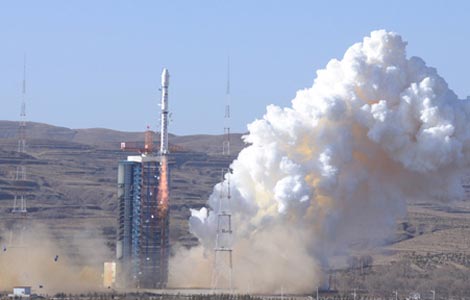China's position paper on South China Sea
Updated: 2014-12-07 10:20
(Xinhua)
|
||||||||
II. The essence of the subject-matter of the arbitration is the territorial sovereignty over several maritime features in the South China Sea, which does not concern the interpretation or application of the Convention
4. China has indisputable sovereignty over the South China Sea Islands (the Dongsha Islands, the Xisha Islands, the Zhongsha Islands and the Nansha Islands) and the adjacent waters. Chinese activities in the South China Sea date back to over 2,000 years ago. China was the first country to discover, name, explore and exploit the resources of the South China Sea Islands and the first to continuously exercise sovereign powers over them. From the 1930s to 1940s, Japan illegally seized some parts of the South China Sea Islands during its war of aggression against China. At the end of the Second World War, the Chinese Government resumed exercise of sovereignty over the South China Sea Islands. Military personnel and government officials were sent via naval vessels to hold resumption of authority ceremonies. Commemorative stone markers were erected, garrisons stationed, and geographical surveys conducted. In 1947, China renamed the maritime features of the South China Sea Islands and, in 1948, published an official map which displayed a dotted line in the South China Sea. Since the founding of the People' s Republic of China on 1 October 1949, the Chinese Government has been consistently and actively maintaining its sovereignty over the South China Sea Islands. Both the Declaration of the Government of the People' s Republic of China on the Territorial Sea of 1958 and the Law of the People' s Republic of China on the Territorial Sea and the Contiguous Zone of 1992 expressly provide that the territory of the People' s Republic of China includes, among others, the Dongsha Islands, the Xisha Islands, the Zhongsha Islands and the Nansha Islands. All those acts affirm China' s territorial sovereignty and relevant maritime rights and interests in the South China Sea.
5. Prior to the 1970s, Philippine law had set clear limits for the territory of the Philippines, which did not involve any of China' s maritime features in the South China Sea. Article 1 of the 1935 Constitution of the Republic of the Philippines, entitled "The National Territory" , provided that "The Philippines comprises all the territory ceded to the United States by the Treaty of Paris concluded between the United States and Spain on the tenth day of December, eighteen hundred and ninety-eight, the limits which are set forth in Article III of said treaty, together with all the islands embraced in the treaty concluded at Washington between the United States and Spain on the seventh day of November, nineteen hundred, and the treaty concluded between the United States and Great Britain on the second day of January, nineteen hundred and thirty, and all territory over which the present Government of the Philippine Islands exercises jurisdiction." Under this provision, the territory of the Philippines was confined to the Philippine Islands, having nothing to do with any of China' s maritime features in the South China Sea. Philippine Republic Act No. 3046, entitled "An Act to Define the Baselines of the Territorial Sea of the Philippines" , which was promulgated in 1961, reaffirmed the territorial scope of the country as laid down in the 1935 Constitution.
6. Since the 1970s, the Philippines has illegally occupied a number of maritime features of China' s Nansha Islands, including Mahuan Dao, Feixin Dao, Zhongye Dao, Nanyao Dao, Beizi Dao, Xiyue Dao, Shuanghuang Shazhou and Siling Jiao. Furthermore, it unlawfully designated a so-called "Kalayaan Island Group" to encompass some of the maritime features of China' s Nansha Islands and claimed sovereignty over them, together with adjacent but vast maritime areas. Subsequently, it laid unlawful claim to sovereignty over Huangyan Dao of China' s Zhongsha Islands. In addition, the Philippines has also illegally explored and exploited the resources on those maritime features and in the adjacent maritime areas.
7. The Philippines' activities mentioned above have violated the Charter of the United Nations and international law, and seriously encroached upon China' s territorial sovereignty and maritime rights and interests. They are null and void in law. The Chinese Government has always been firmly opposed to these actions of the Philippines, and consistently and continuously made solemn representations and protests to the Philippines.
8. The Philippines has summarized its claims for arbitration in three categories:
First, China' s assertion of the "historic rights" to the waters, sea-bed and subsoil within the "nine-dash line" (i.e., China' s dotted line in the South China Sea) beyond the limits of its entitlements under the Convention is inconsistent with the Convention.
Second, China' s claim to entitlements of 200 nautical miles and more, based on certain rocks, low-tide elevations and submerged features in the South China Sea, is inconsistent with the Convention.
Third, China' s assertion and exercise of rights in the South China Sea have unlawfully interfered with the sovereign rights, jurisdiction and rights and freedom of navigation that the Philippines enjoys and exercises under the Convention.
9. The subject-matter of the Philippines' claims is in essence one of territorial sovereignty over several maritime features in the South China Sea, which is beyond the scope of the Convention and does not concern the interpretation or application of the Convention. Consequently, the Arbitral Tribunal has no jurisdiction over the claims of the Philippines for arbitration.
10. With regard to the first category of claims presented by the Philippines for arbitration, it is obvious that the core of those claims is that China' s maritime claims in the South China Sea have exceeded the extent allowed under the Convention. However, whatever logic is to be followed, only after the extent of China' s territorial sovereignty in the South China Sea is determined can a decision be made on whether China' s maritime claims in the South China Sea have exceeded the extent allowed under the Convention.
11. It is a general principle of international law that sovereignty over land territory is the basis for the determination of maritime rights. As the International Court of Justice ( "ICJ" ) stated, "maritime rights derive from the coastal State' s sovereignty over the land, a principle which can be summarized as 'the land dominates the sea' " (Maritime Delimitation and Territorial Questions between Qatar and Bahrain (Qatar v. Bahrain), Merits, Judgment of 16 March 2001, I.C.J. Reports 2001, p. 97, para. 185; cf. also North Sea Continental Shelf (Federal Republic of Germany/Denmark; Federal Republic of Germany/Netherlands), Judgment of 20 February 1969, I.C.J. Reports 1969, p. 51, para. 96; Aegean Sea Continental Shelf (Greece v. Turkey), Jurisdiction of the Court, Judgment of 19 December 1978, I.C.J. Reports 1978, p. 36, para. 86). And, "[i]t is thus the terrestrial territorial situation that must be taken as starting point for the determination of the maritime rights of a coastal State" (Qatar v. Bahrain, I.C.J. Reports 2001, para. 185; Territorial and Maritime Dispute between Nicaragua and Honduras in the Caribbean Sea (Nicaragua v. Honduras), Judgment of 8 October 2007, I.C.J. Reports 2007, p. 696, para. 113). Recently the ICJ again emphasized that "[t]he title of a State to the continental shelf and to the exclusive economic zone is based on the principle that the land dominates the sea" , and that "the land is the legal source of the power which a State may exercise over territorial extensions to seaward" (Territorial and Maritime Dispute (Nicaragua v. Colombia), Judgment of 19 November 2012, I.C.J. Reports 2012, p. 51, para. 140).
12. The preamble of the Convention proclaims "the desirability of establishing through this Convention, with due regard for the sovereignty of all States, a legal order for the seas and oceans" . It is apparent that "due regard for the sovereignty of all States" is the prerequisite for the application of the Convention to determine maritime rights of the States Parties.
13. As far as the present arbitration is concerned, without first having determined China' s territorial sovereignty over the maritime features in the South China Sea, the Arbitral Tribunal will not be in a position to determine the extent to which China may claim maritime rights in the South China Sea pursuant to the Convention, not to mention whether China' s claims exceed the extent allowed under the Convention. But the issue of territorial sovereignty falls beyond the purview of the Convention.
14. The Philippines is well aware that a tribunal established under Article 287 and Annex VII of the Convention has no jurisdiction over territorial sovereignty disputes. In an attempt to circumvent this jurisdictional hurdle and fabricate a basis for institution of arbitral proceedings, the Philippines has cunningly packaged its case in the present form. It has repeatedly professed that it does not seek from the Arbitral Tribunal a determination of territorial sovereignty over certain maritime features claimed by both countries, but rather a ruling on the compatibility of China' s maritime claims with the provisions of the Convention, so that its claims for arbitration would appear to be concerned with the interpretation or application of the Convention, not with the sovereignty over those maritime features. This contrived packaging, however, fails to conceal the very essence of the subject-matter of the arbitration, namely, the territorial sovereignty over certain maritime features in the South China Sea.

 China, Brazil pledge to promote science, technology co-op
China, Brazil pledge to promote science, technology co-op
 ZTE, NBA team partners in business, charity
ZTE, NBA team partners in business, charity
 'Big' Peking opera staged in New York
'Big' Peking opera staged in New York
 250 Santas hit slopes for charity
250 Santas hit slopes for charity
 Jack Ma awarded Honorary Chairman of Zhejiang Chamber of Commerce
Jack Ma awarded Honorary Chairman of Zhejiang Chamber of Commerce
 2014 Yearender: Life underground
2014 Yearender: Life underground
 South China's 'little Africa'
South China's 'little Africa'
 Trending: Eiffel Tower replica in Hangzhou
Trending: Eiffel Tower replica in Hangzhou
Most Viewed
Editor's Picks

|

|

|

|

|

|
Today's Top News
Illinois university signs agreements with Chinese college
ZTE, NBA team partner in business, charity
Chinese investors in Brazil told to avoid risks
Economists call for increased public spending in China
Xiaomi's smartphone taps into US market
Peruvian product hit in Chinese market
Chinese role expected in Mexico's energy reform
Brazil film festival delights Beijing and Shanghai
US Weekly

|

|







